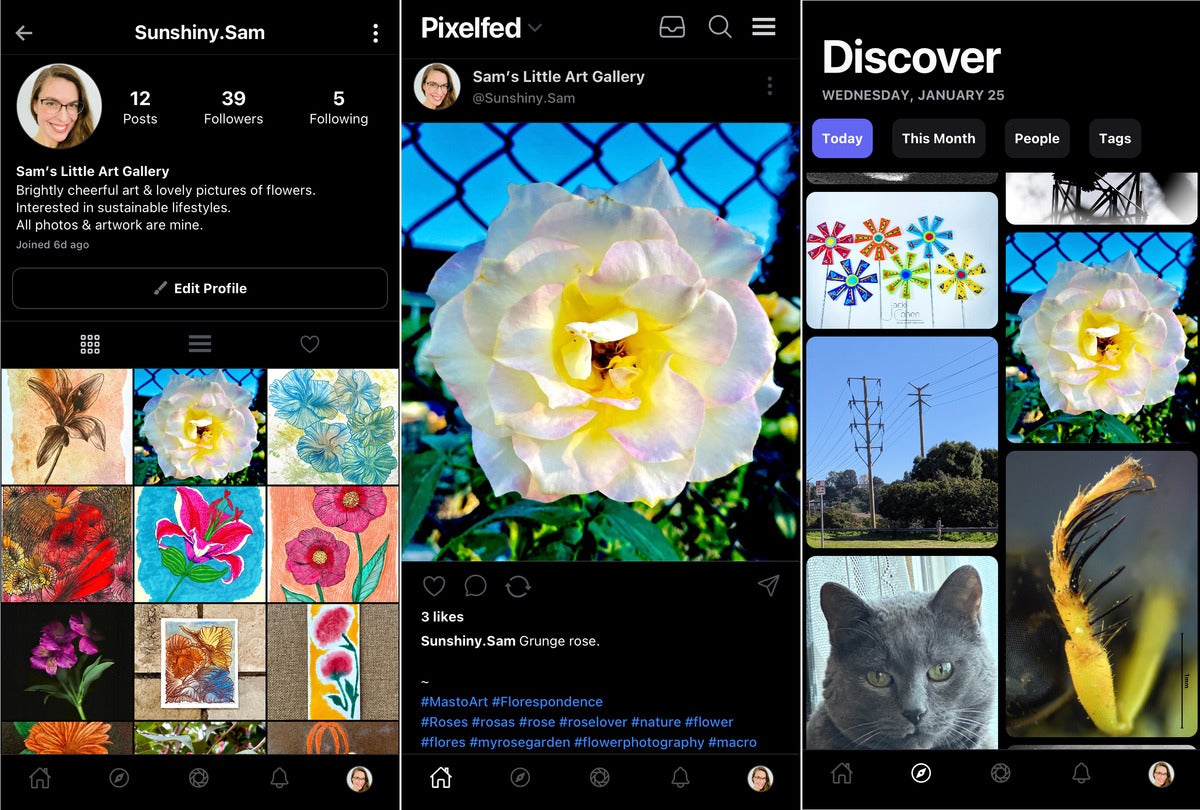
Give unto Elon what is Elon’s and give unto us what is ours. Social media may never have been a great idea. It is like the capitalist answer to Maoist self-criticism. You confess all of your vanity in one place and hope that the people who own the site will use it for good.
On the whole, the influence of social media on society, especially on socialization, seems to have been negative, and people have been quiet quitting—or not-so-quiet quitting—Facebook, Twitter, Instagram, and YouTube for some time. With Musk’s purchase of Twitter and his rapid-fire (and arguably rash) decision-making, many social media enthusiasts have been trickling into not Facebook’s metaverse but something called “the fediverse.”
What is the fediverse?
The fediverse is a network of social media servers that share one another’s content. The most famous example is Mastodon, which is a lot like Twitter. However, instead of one “Twitter” there are many Mastodons (apparently the verdict of extinction was premature). If I set up my account on one server and you set up your account on another server, we can still see and repost each other’s content because the servers are part of a “federation.”
Each Mastodon server has its own policies and administrators. If you do not like them, you can leave one for another without losing followers. Most servers follow the Mastodon Covenant, which requires a basic level of administrative service as well as active moderation against various forms of hate speech. Servers that don’t follow the covenant will not be listed by the core Mastodon site. Also, non-compliant servers will tend to be blocked by other servers, so their content will not be seen by the rest of the fediverse.
Through a set of community-developed open source software and standards, anyone can set up their own alternative to Twitter, Instagram, or YouTube. As long as they agree to the minimum standards in the Mastodon Covenant, they will have access to an instant audience and community of users who are already posting.
Naturally, many of these instances cater to specific languages, geographies, or interests. So if you are, for instance, a self-published author you might join an instance devoted to people such as yourself. Additionally, different instances enforce additional content moderation (at least in theory) and block content from servers that do not. For example, maybe you do not want to be on an instance that hosts pornography.
Why are Twitter, Facebook, and Instagram bad?
People have raised a number of issues with Facebook such as the manipulation of users and the ubiquity of annoying ads and fake news. While one person’s content moderation is another’s censorship, Twitter, Facebook, and Instagram have seemed to utterly fail at moderating content in a way acceptable to anyone. In many cases they have seemed to encourage misinformation, fake news, and even hate speech in order to drive “engagement.”
I personally quiet quit Facebook after the company, despite numerous reports, refused to take down a user with a fake name who doxxed a friend and was menacing a number of women online. My use of the service, like many others, had already dwindled to a trickle over the years. Instagram, which is also owned by Facebook’s parent company Meta, is known to have similar problems with moderation, manipulation, and loads and loads of spam.
Twitter was purchased by Elon Musk reportedly in order to promote his ideas of free speech. He immediately began reinstating controversial figures known for hate speech and hostility to minority groups. At the same time he silenced other people for making fun of him or publishing the location of his private jet. Musk’s other decisions resulted in farcical results, with spoof accounts of famous brands getting blue check marks of authenticity. You can read more about that in the Economist, New York Times, Washington Post, Guardian, Time Magazine, and the website of the Brookings Institute, among others.
YouTube now has the kinds of ads that made you leave broadcast TV. It also algorithmically recommended junk science videos during the height of the Covid pandemic and promoted other misinformation. However, this content is super engaging to the people it doesn’t disgust or repulse.
For all of these services, it seems the user manipulation has produced short-term gains. But who actually “likes” these services anymore? You’re there out of some mysterious obligation. If your experience is like many, you will start using them less and less because they make you feel… bad.
The ultimate question is whether having a digital “public space” in the hands of a single billionaire or any corporation with a profit motive is fundamentally a bad thing. Nearly everything that is done to “monetize” user content and engagement tends to disadvantage the users and their content. This includes what content the algorithms show you in your feed and which ads you are served. It also includes which features get added, like “trends” or “Fleets.”
What is the fediverse Twitter?
As I mentioned earlier, Mastodon is the fediverse answer to Twitter. It is also the most mature part. There are a few differences, like a 500 character limit, and posts are called toots instead of tweets, but overall it works the same way. News, hashtags, and feeds are more useful and relevant. The feed is just chronological rather than some manipulation of posts and additional stuff you wish Twitter would not show you. There are a few glitches, especially if you use the Android app and the website. For instance, Mastodon did not sync the follower/following count or profile picture between them until I clicked edit. But overall Mastodon is just as easy to use as Twitter.
 IDG
IDG
What is the fediverse Instagram?
The fediverse answer to Instagram is Pixelfed. According to one user, @Sunshiny.Sam, “It is so similar to Instagram I forget which one I’m using.” The layout is similar, including the profile screen, hashtags, and alerts. There are differences. “Local” means the Pixelfed server that you are using; it has nothing to do with your actual location. You’ll see images from all over the fediverse and even from Mastodon, but text-only posts are filtered. There is a reshare button, but it does something different than what you might expect.
 IDG
IDG
Pixelfed iPhone app running against Pxlmo server. Credit to @Sunshiny.Sam.
However, it is clearly the early days in the Pixelfediverse. There is no Android app yet and the iPhone app is in beta and has a number of glitches. Notifications in the app do not work. Messaging is, for all intents and purposes, non-functioning. When you reply to comments, they do not show in the app, but they do show up on the website. The search is glitchy, and search for hashtags is not working at the time of writing. Some other features seem to work one day and not the next. Yet both the website and the app are usable.
Whereas Instagram and Twitter have a border wall between them, you can see posts between Pixelfed and Mastodon. However, there is some weirdness between the two. People on Mastodon instances can see posts from Pixelfed instances. When they “boost” (repost) your picture you’ll get a notification, but if you look at their profile it often says they have no followers and no posts. And, oddly, my Mastodon account hasn’t sync’d the last four days of posts from a Pixelfed user I follow, despite my being able to see the posts on Pixelmo.
The federated answer to YouTube
The federated version of YouTube is called PeerTube. It works just how you would expect. Publishing videos and joining a server are easy. The playback is quite snappy. PeerTube innovates on the design of most video sharing services in that it uses a peer-to-peer protocol (similar to BitTorrent) to augment video stream downloads. Sadly I can’t just cast videos to my Chromecast like I can on YouTube without sharing my whole screen. However, that is to be expected as Chromecast is proprietary Google technology.
As for content, there is not yet the kind of awful stuff you might find on YouTube. I searched for stuff I actually do not want to see and got perfectly innocent results. However, when I searched for MariaDB content, I only found two-year-old video uploads that covered a five-year-old version of MariaDB Community Server. So PeerTube is probably not where you’re going to watch your “how to” videos for now. It’s a great place to share with your friends, but not yet a go-to site.
What about TikTok?
Well if you aren’t happy with Facebook, Twitter, Instagram, and YouTube, why not head into the loving arms of the Chinese government? According to Mastodon founder Eugen Rochko, “We won’t see a federated TikTok because the core of what made TikTok popular is an advanced video recording and editing app and an advanced content discovery algorithm. It is not enough to create a server that accepts video file uploads and distributes them to followers and call it ‘federated TikTok’.” So there may not be a federated web of sites for learning dance moves anytime soon.
APIs and their potential
Twitter famously manipulated and hobbled their APIs, disabled third-party apps, and made it painfully clear whose sandbox a developer is playing in. Mastodon’s robust REST APIs are based on ActivityPub, a W3C standard. Aside from supporting third-party apps, Mastodon makes it possible to do more of the search and research on text and trends that we used to do using the Twitter API. For example, you can get the firehose for the whole fediverse—if you dare.
Some of Twitter’s famed ecosystem is migrating over to the fediverse, and the number of third-party apps is growing fast. For example, Tusker promises to customize your timeline and supports both Pixelfed and Mastodon. For some power users, the app Tweetbot “was Twitter,” but after Twitter killed third-party apps the Tweetbot developers launched an app called Ivory for Mastodon (currently an early access preview). If those are not to your liking you can turn to Ice Cubes, Woolly, Mona, or Mammoth.
Should you join the fediverse?
For now, both Mastodon and Pixelfed feel safer than their non-federated counterparts. According to @Sunshiny.Sam, “It feels more like a community. In the week I’ve been active on Pixelfed, I’ve gotten nice comments on my artwork, and that’s all. I haven’t gotten any of the annoying business messages.”
I for one am on social media not because I want to be, but because I have to be for my job. I use social media to find events. I use it to check on my son’s going ons in college. I cannot “just quit” and move to Mastodon because the audience is not there and more importantly my network isn’t there. When this article is published I’ll probably post it both on my Mastodon account and on Twitter.
However, I don’t really read Twitter much anymore. The content selection shows me more fluff than stuff. In one week on Mastodon I had already found more interesting stuff and had to filter through less noise. Granted, I am following fewer people, but also Mastodon is not showing me stuff from people I do not follow unless I ask it to.
In the early days of the internet, the web promised to democratize publishing and let everyone participate. However, one of the features of the early web was that it was not particularly easy to use. The bar to entry was somewhat high. On the one hand, that meant that non-technical people were underrepresented. On the other hand, you had to have at least some smarts to publish. It is hard to avoid the conclusion that some of the decline in the quality of content is due to lowering the bar.
For now, the fediverse audience is small and the motivation to create spambots and flood the network with fake news is low. Moreover, if you figured out how to get on Mastodon then probably you’re not the average Facebook user, you are a little less likely to fall for the next Pizzagate, and you make a poor target for fake news.
However, if the fediverse grows, so will the motivation for malfeasance. Mastodon proponents point to the structure of the network and to the fact that bots tend to create engagement to manipulate the feed—something they can’t easily do in the fediverse. Their faith strikes me as unwarranted. Twitter and Facebook decided they needed AI tools to patrol their networks. Assuming the fediverse continues to grow, will AI be needed to filter content and flag bad behavior? Or will the nature of decentralization be enough? Only time will truly tell.
For now, I’m stuck straddling both the corporate-owned and the community-owned networks. I’ll keep posting to both and letting my audience build in the fediverse. Despite the rough edges and glitches, I enjoy reading Mastodon and scanning Pixelfed. The content, though more sparse, is either stuff I’m interested in or at least not manipulative. While I’m posting on both Twitter and Mastodon for now, I’m actually reading my Mastodon feed.
Copyright © 2023 IDG Communications, Inc.
Originally posted on February 20, 2023 @ 1:00 pm

